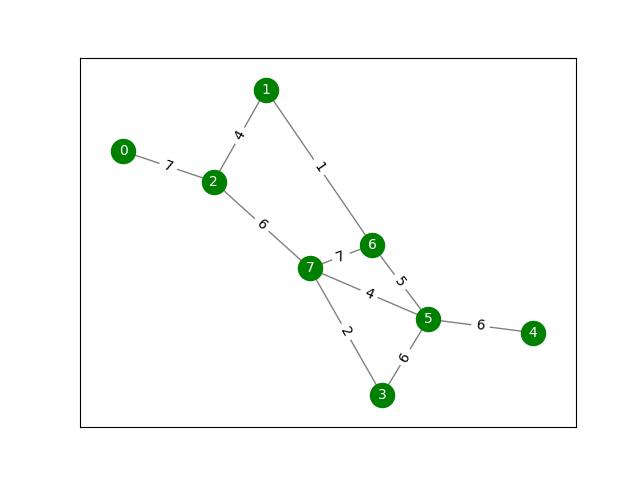networkx图论Dijkstra Algorithm最短路径实现,Python
Posted zhangphil
tags:
篇首语:本文由小常识网(cha138.com)小编为大家整理,主要介绍了networkx图论Dijkstra Algorithm最短路径实现,Python相关的知识,希望对你有一定的参考价值。
自己用Python写的Dijkstra实现,熟悉,练手。
Dijkstra Algorithm的关键要点:
(1)初始阶段,设定所有的节点权值为无穷大,float('inf')。
(2)更新每个节点的权值。权值的产生是由当前节点的权值(node weight)+与之相连的边权(edge weight)决定。如果求和后的权值小于与之连接的节点,更新其权值为这个最小的值,如果大于下一个节点原本的节点权值,不更新。
寻路从0节点出发,那么设定0节点的权值node weight = 0。然后计算0节点到与之相连接的节点权值,0节点的权值+边权(edge weight)即为与之相连节点的权值,从而得到0节点到该节点的node weight。从节点0开始更新,因为与节点0相连接的节点初始值都为无穷大,那么直接0+边权(edge_weight)即为下一个节点的新权值(松弛操作)。
再比如说,cur_node的权值(cur_node_weight)是1,与cur_node相连接其中一个next_node的权值(next_node_weight)是5。cur_node与next_node相连接的边(edge)权值(edge_weight)为3,那么 1+3=4,4<5,那么更新next_node的最新权值为4。又假设cur_node_weight=6,6+3=9,9>5,那么next_node的权值保持原状不更新,依然是5。
(3)当选定某个节点V后(比如上一步是0,V=0),更新与之相连接的节点权值。如何选择V下一个节点?以节点0为例,当把所有与0相连的节点通过 0 + edge_weight = next_node_weight后,从全部图中的节点(除close_list外的节点,此时close_list里面只有一个0)取最小值那个节点,作为next_node。同时要把这个next_node放入到close_list。注意,这个next_node不一定和V相连。
建立一个close_list保存那些已经确定为0到当前节点最短路径确定好的点,close_list里面的节点不再参与后面的节点权值比较。
(4)关于计算0到某个顶点V的最短路径策略。通过上述的全部轮次迭代后,图中所有节点的权值都已经得到更新。
此时,图中所有更新后的节点权值(node_weight),即为节点0(出发点、源点)到该节点的最小距离(node_weight,此时 path_lenght == node_weight)。
下面开始找到具体路线,找具体路线的策略和之前的不同,是另外一直逆操作。以0到5的最短路径为例。首先已经知道节点5的节点权值(node_weight),然后获取与节点5相连接的所有边通往的节点。具体思路是:节点5的权值(node_weight)减去与节点5相连接的边权(edge_weight),得出前一个节点的权值(pre_node_weight)。此时,再次遍历所有与节点5相连接的节点V,如果V的节点权值(node_weight)刚好等于pre_node_weight,那么这个节点就是与节点5连接的最短路径节点。
然后递归,再以pre_node为起始节点,依照上述策略,步步逆向往上进逼,找到上一个节点(pre_node),直到找到节点0为止。
(5)Dijkstra Algorithm最大的问题是不适用边权为负值的最短路径搜索。因为这会导致循环的node_weight +(负值边权)不停的变小,寻路算法陷于死循环。不过通常,似乎也没有边权为负值的算法场景出现。
代码:
import random
import networkx as nx
import matplotlib.pyplot as plt
WEIGHT = 'weight'
def my_graph():
# 随机生成一个图,8个node,10条edge
G = nx.gnm_random_graph(8, 10)
# 为图中的边增加随机的权
for e in G.edges(data=True):
e[2][WEIGHT] = random.randint(1, 8)
pos = nx.spring_layout(G)
nx.draw_networkx(G, pos,
node_color='green',
node_size=300,
font_size=10,
font_color='white',
edge_color='gray',
width=1,
with_labels=True)
g_edge_labels = nx.get_edge_attributes(G, WEIGHT)
nx.draw_networkx_edge_labels(G, pos, edge_labels=g_edge_labels)
# 设置所有节点的权值为无穷大
for n in G.nodes():
G.nodes[n][WEIGHT] = float('inf')
# 更新第一个节点权重为0
G.nodes[0][WEIGHT] = 0
print('G.nodes(data=True)', G.nodes(data=True))
print('G.edges(data=True)', G.edges(data=True))
START = list(G.nodes())[0]
print('起点', START)
close_list = [START]
vertex = START # 顶点
while True:
print('-----')
if len(close_list) == G.number_of_nodes():
break
update_weight_from_node(G, vertex, close_list)
min_node = find_min_nodes(G, vertex, close_list)
vertex = min_node[0]
close_list.append(vertex)
print('colse_list', close_list)
print('G.nodes(data=True)', list(G.nodes(data=True)))
target = 5
path = find_short_path(G, target)
print('最短路径 0 ->', target, list(path))
print('\\n==标准dijkstra找到的最短路径==')
print(dijkstra_find_path(G, 0, target))
plt.show()
# 寻找从0节点到v的最短路径
def find_short_path(G, v):
path = [v]
loop_flag = True
while loop_flag:
v_node_weight = G.nodes[v][WEIGHT]
ok_node = None
for from_node in nx.neighbors(G, v):
from_node_weight = G.nodes[from_node][WEIGHT]
edge_weight = G.get_edge_data(u=from_node, v=v)[WEIGHT]
if (from_node_weight + edge_weight) == v_node_weight:
ok_node = from_node
break
if ok_node != None:
path.append(ok_node)
if ok_node == 0:
loop_flag = False
else:
v = ok_node
list.reverse(path)
return path
def find_min_nodes(G, vertex, close_list):
min_node_list = []
for node in G.nodes(data=True):
if (node[0] not in close_list) and node[0] != vertex:
min_node_list.append(node)
min_node = min(min_node_list, key=lambda x: x[1][WEIGHT])
print(vertex, '最小节点', min_node)
return min_node
def update_weight_from_node(G, from_node_value, close_list):
form_node_weight = G.nodes[from_node_value][WEIGHT]
neighbors = nx.neighbors(G, from_node_value)
for to_node in neighbors:
if to_node in close_list:
continue
edge_weight = G.get_edge_data(u=from_node_value, v=to_node)[WEIGHT]
to_node_weight = G.nodes[to_node][WEIGHT]
sum_weight = form_node_weight + edge_weight
if sum_weight < to_node_weight:
G.nodes[to_node][WEIGHT] = sum_weight
print('更新节点权值', from_node_value, '->', to_node, '新权值为:', sum_weight)
def dijkstra_find_path(G, START, END):
print(START, '->', END)
path = nx.dijkstra_path(G, source=START, target=END)
print('Dijkstra-最短路径:', path)
path_length = nx.dijkstra_path_length(G, source=START, target=END)
print('Dijkstra-最短距离:', path_length)
if __name__ == '__main__':
my_graph()
生成的图:

运行日志:
G.nodes(data=True) [(0, {'weight': 0}), (1, {'weight': inf}), (2, {'weight': inf}), (3, {'weight': inf}), (4, {'weight': inf}), (5, {'weight': inf}), (6, {'weight': inf}), (7, {'weight': inf})]
G.edges(data=True) [(0, 2, {'weight': 7}), (1, 6, {'weight': 1}), (1, 2, {'weight': 4}), (2, 7, {'weight': 6}), (3, 7, {'weight': 2}), (3, 5, {'weight': 6}), (4, 5, {'weight': 6}), (5, 6, {'weight': 5}), (5, 7, {'weight': 4}), (6, 7, {'weight': 7})]
起点 0
-----
更新节点权值 0 -> 2 新权值为: 7
0 最小节点 (2, {'weight': 7})
colse_list [0, 2]
-----
更新节点权值 2 -> 1 新权值为: 11
更新节点权值 2 -> 7 新权值为: 13
2 最小节点 (1, {'weight': 11})
colse_list [0, 2, 1]
-----
更新节点权值 1 -> 6 新权值为: 12
1 最小节点 (6, {'weight': 12})
colse_list [0, 2, 1, 6]
-----
更新节点权值 6 -> 5 新权值为: 17
6 最小节点 (7, {'weight': 13})
colse_list [0, 2, 1, 6, 7]
-----
更新节点权值 7 -> 3 新权值为: 15
7 最小节点 (3, {'weight': 15})
colse_list [0, 2, 1, 6, 7, 3]
-----
3 最小节点 (5, {'weight': 17})
colse_list [0, 2, 1, 6, 7, 3, 5]
-----
更新节点权值 5 -> 4 新权值为: 23
5 最小节点 (4, {'weight': 23})
colse_list [0, 2, 1, 6, 7, 3, 5, 4]
-----
G.nodes(data=True) [(0, {'weight': 0}), (1, {'weight': 11}), (2, {'weight': 7}), (3, {'weight': 15}), (4, {'weight': 23}), (5, {'weight': 17}), (6, {'weight': 12}), (7, {'weight': 13})]
最短路径 0 -> 5 [0, 2, 1, 6, 5]
==标准dijkstra找到的最短路径==
0 -> 5
Dijkstra-最短路径: [0, 2, 1, 6, 5]
Dijkstra-最短距离: 17以上是关于networkx图论Dijkstra Algorithm最短路径实现,Python的主要内容,如果未能解决你的问题,请参考以下文章